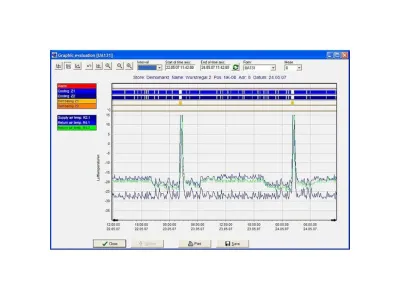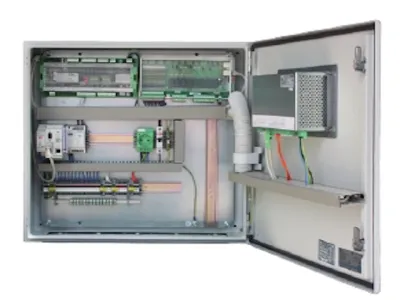Defrost supermarket refrigerated cabinets and refrigerator
Introduction to the topic of defrosting refrigerated cabinets and cold stores in supermarkets
According to the second law of thermodynamics, heat can only pass from the higher-energy object to the lower-energy object. In this case lit, the supermarket refrigerated cabinets, the cold air absorbs the heat of the goods and is promoted by the fan generated airflow to the evaporator. The heated air then flows through the cold evaporator and releases the heat absorbed by the goods to the evaporator. It creates a "cycle" of air flow in the refrigerator.
Thus, the heat from the refrigerated goods can be transferred to the refrigeration system, so the evaporator must always be the coldest "point" in the refrigerator or refrigerator.
If the temperature falls below the dew point when this air cools, atmospheric moisture is released on the evaporator surface. "Same principle as with cold beer on a hot summer day on the pub table. The humidity hits the glass and water runs down the beer glass ".
If the surface temperature is colder than 0 ° C (as in most cases) this precipitated water freezes on the fins and tubes of the evaporator. Consequently, "snow" or icing on the evaporator, which without a defrost very quickly become a problem. The frozen water grows into a dense snow or ice layer and then obstructs the air flow of the fan. In the worst case, the air flow through the ice layer is completely interrupted and it comes to over-temperature in the refrigerator.
To detect this problem is by checking with the hand at the air outlets of the refrigeration equipment, whether an air flow is tangible. If there is no more air out there, the refrigerator is iced up. Other causes may include a faulty evaporator fan or a heavy contamination.
Types of defrost
Free Air
This defrost is by far the most energetically sensible kind.
Here, as the name already suggests, the circulation of air is used for defrosting. For the duration of the defrost, the cooling is switched off by the control of the refrigeration system and an air circulation ensured by the evaporator fans. The circulated "warm" air now defrosts the ice on the evaporator. This defrost variant, however, can only be realized with Mopro and in part meat refrigerated shelves as well as normal cold rooms.
After a previously defined time or defrost end temperature has been reached, the defrost is ended and the control restarts the cooling operation.
electric defrost
Defrosting by means of electric heaters is predominantly used in freezer cabinets and deep-freeze rooms. Since no circulating air defrosting is possible due to the low ambient temperatures, the ice build-up on the evaporator fins must be defrosted here by means of electric heaters. These heaters usually sit in and in the direction of air before the evaporator package. In order not to distribute the introduced heat of the defrost heaters, during the defrost, in the refrigerator or refrigerator, the fans must be turned off.
Hot gas defrosting
Here, the hot gas generated by the compressor (superheated refrigerant), by switching certain valves, passed through the evaporator. This type of defrost is the most cost effective option for the freezer cabinets and freezers, in terms of energy costs. Since the COP (coefficient of performance) in hot gas defrosting is many times higher than in the case of electric defrosting.
Example for a better understanding:
The electric heater has a COP of 1, means 1 KW of electric power are needed for the heating power of 1 KW.
Hot gas defrosting requires 1 kW of power as the drive power of the compressor, resulting in a hot power of 4 kW. Then you would have a COP of 4.
This example is only for the sake of understanding. The actual COP of a hot gas defrost depends on a lot of plant parameters. On the one hand, the choice of refrigerant plays a role, on the other hand, the operating points of the refrigeration system to name just a few. Bottom line, but you can say that a hot gas defrost always worthwhile. Especially with regard to rising energy costs.
Normal cooling
dairy products cabinets
The Mopro (dairy products) refrigerated shelves are always defrosted by means of circulating air defrosting. If there is no thermal defrost limit, one can expect a defrost duration of 30 - 45 minutes. The thermal limitation of the defrost is via a temperature sensor which is installed on the evaporator. If a set temperature is exceeded, the defrost is ended and cooling then starts again.
meat cabinets
Depending on the refrigerator manufacturer different. It comes here the Umluft Abtauung but also electric defrost heaters used. For this reason, you should inquire before buying the refrigerator exactly what defrosting variant of the refrigeration furniture manufacturer requires. Good refrigeration units can cope even without a defrost heater.
service counters
The same as for the meat cooler shelf applies to the service counter, but an electric defrost has become rather rare. Mainly the service counter is defrosted by circulating air defrosting.
plus cooling cabinets
In Pluskühlräume with a room temperature up to + 4C ° a Umluft Abtauung is readily feasible. However, if you come to the area of sausage and meat cold rooms, which require a room temperature of approx. + 1 ° C, recirculation defrosting becomes more difficult.
Here, the temperature difference of evaporator surface (or evaporation temperature) to room temperature plays an important role. The larger the evaporator surface, the smaller the required temperature difference between room temperature and evaporation temperature at constant cooling capacity. A major advantage here is that the evaporation temperature of the refrigeration system can be raised, which contributes significantly to energy conservation. The advantage for circulating air defrosting is that the evaporator is rather "wet" instead of being frosted or the formation of frost is reduced.
If a "smaller" evaporator with a large temperature difference is selected, an electric defrost must be selected to defrost the evaporator. In addition, here a lower evaporation temperature must be provided to achieve the required cooling capacity.
Freezing
Frozen isles
The deep-frozen island popular in the supermarket always needs a hot gas or electric defrost.
Electric defrosting is by far the most common type of these freezers. In order to keep the heat input to the goods as low as possible, the evaporator fans are turned off during defrost. This prevents the warm air in the furniture from being unnecessarily distributed. After reaching a certain evaporator package temperature, the defrost is ended (defrost end temperature). After defrosting the "dripping time" begins, in which the condensate "drips" should. At the end of this set time, the refrigeration unit starts cooling again. In order not to distribute the heat of the defrost heaters and the evaporator, the evaporator fans are still standing still here. Only when the evaporator has reached a set temperature, the fans start up. And the defrosting process is over.
The frequency of defrost cycles depends on the types of refrigeration units and the environmental conditions.
If it is "open" frozen islands, so without glass lid, one must expect at a high humidity (for example: rainy day in the summer) with up to 3 defrosts per day.
With "closed" deep-frozen islands, with glass lid, the defrost cycles can be reduced to 3 defrosts per week! If one now assumes a defrosting power of approx. 7KW, with a furniture length of 3.75m, this is an enormous energy saving potential!
Freezer
The freezer is very vulnerable to humidity! Depending on the manufacturer, at least 1 electrical or hot gas defrost per day must be expected in this design. As with every door opening a large part of warm air and thus also moisture are brought into the closet. Again, the fans to keep the heat input during defrosting low, turned off.
After reaching a certain evaporator package temperature, the defrost is ended (defrost end temperature). After defrosting the "dripping time" begins, in which the condensate "drips" should. After this set time, the refrigerated cabinets will start cooling again.
In order not to distribute the heat of the defrost heaters and the evaporator, the evaporator fans are still standing still here. Only when the evaporator has reached a set temperature, the fans start up. And the defrosting process is over.








